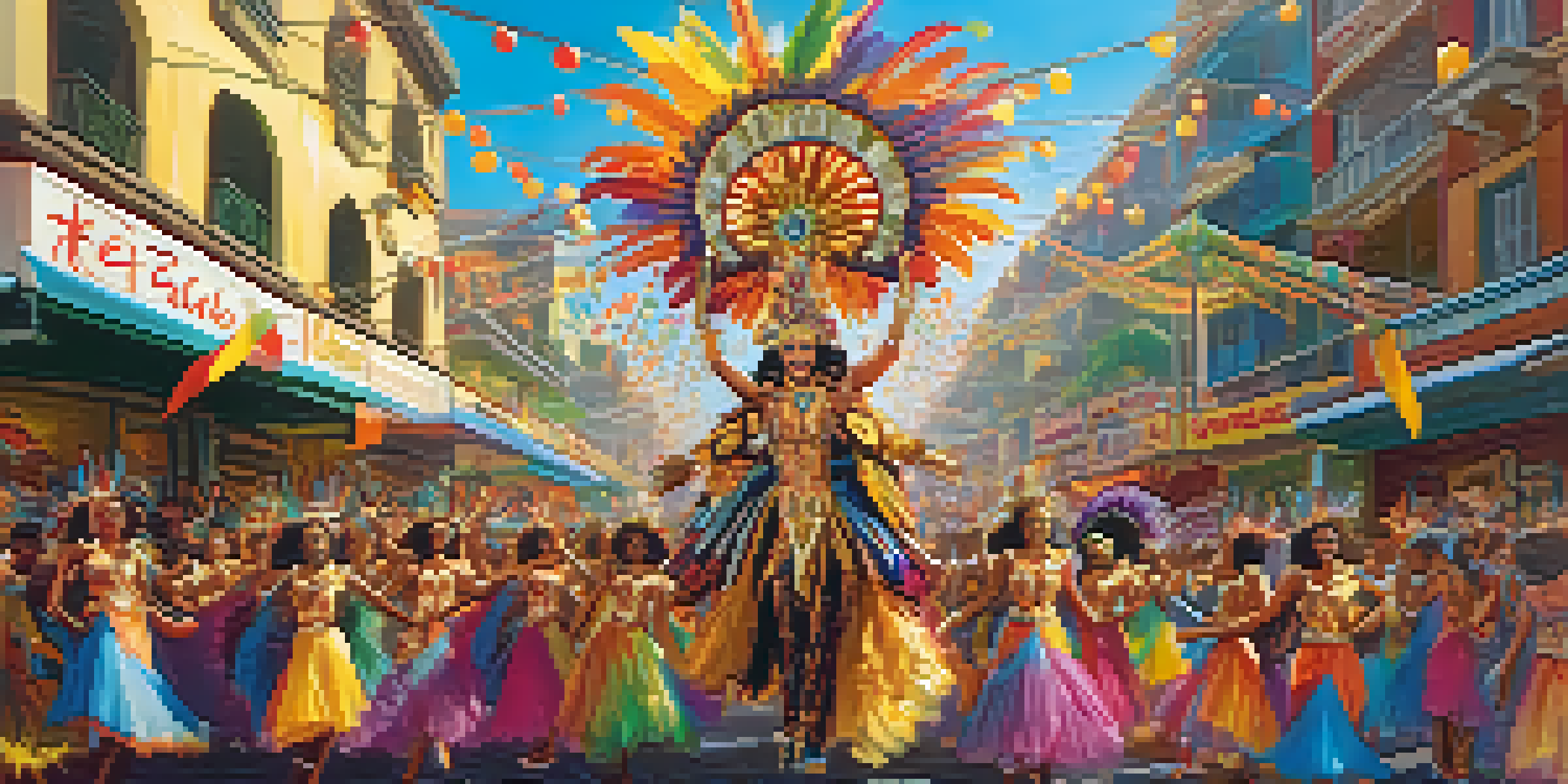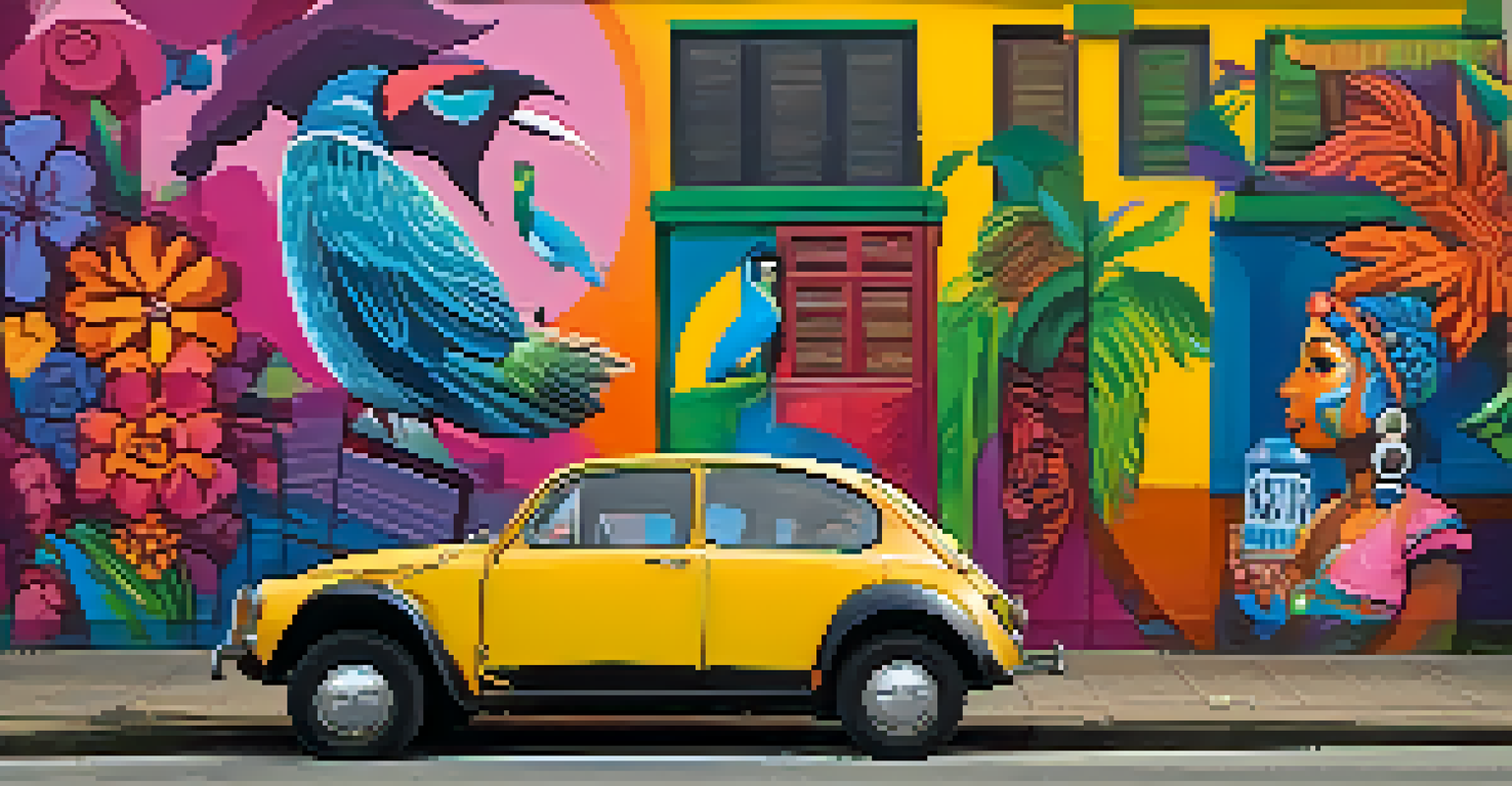The Magic of Folkloric Characters in Brazilian Festival Celebrations

Introduction to Brazilian Folkloric Characters
Brazilian folklore is rich with colorful characters, each telling a unique story. These figures, often rooted in indigenous, African, and European traditions, bring life to the country's festivals. They reflect the diverse cultural heritage of Brazil, making each celebration a vibrant tapestry of history and creativity.
Folklore is the heart of a culture, and it connects us to our past and present, enriching our lives with stories and traditions.
From the mischievous Saci to the enchanting Iemanjá, these characters embody various traits and values. They often personify elements of nature, social issues, or moral lessons, engaging festival-goers in a deeper understanding of Brazil's cultural narratives. This blend of mythology and reality creates a captivating atmosphere at celebrations across the nation.
During festivals, these characters come alive through colorful costumes, music, and dance. They invite participants to join in the fun, breaking down barriers and fostering a sense of community. This interaction is what makes Brazilian festivals truly special, as they connect people through shared stories and experiences.
The Role of Folkloric Characters in Carnival
Carnival is perhaps the most famous festival in Brazil, showcasing an array of folkloric characters. Samba schools often incorporate these figures into their parades, creating stunning floats and performances that celebrate their heritage. The vibrant costumes and rhythmic music bring these characters to life, captivating audiences and participants alike.

One of the most iconic characters of Carnival is the 'Rei Momo,' the King of Carnival, who symbolizes joy and revelry. He leads the festivities, embodying the spirit of celebration and fun. His presence encourages everyone to let loose and embrace the magic of the moment, making Carnival a time of unity and happiness.
Folklore Enriches Brazilian Culture
Brazilian folkloric characters reflect the country's diverse heritage and play a vital role in its festivals.
Moreover, the storytelling aspect of these characters adds depth to the festivities. Each performance is a blend of tradition and innovation, allowing new generations to connect with their roots. This cyclical nature of folklore keeps the culture alive, ensuring that the stories of these characters continue to enchant future festival-goers.
Folkloric Characters in Festa Junina Celebrations
Festa Junina, celebrated in June, is another festival where folkloric characters play a significant role. This celebration honors rural life, featuring characters like the 'caipira,' a traditional countryman who represents simplicity and joy. His presence is felt in the music, dance, and traditional foods during the festivities.
Tradition is not the worship of ashes, but the preservation of fire.
The 'noiva' (bride) and 'noivo' (groom) are also prominent figures in Festa Junina, symbolizing love and community. Their playful interactions during the festivities showcase the importance of relationships and social bonds in Brazilian culture. This character dynamic adds a layer of fun and relatability, making the festival an enjoyable experience for all ages.
The use of folklore in Festa Junina reinforces cultural pride and identity. Through games, dances, and storytelling, participants are reminded of their roots and the importance of community. This connection to tradition is what makes the festival a heartwarming event, filled with laughter and joy.
The Influence of Folklore on Music and Dance
Music and dance are integral to Brazilian festivals, heavily influenced by folkloric characters. Each character often has associated rhythms and dances that reflect their stories and traits. For instance, the lively 'frevo' dance, known for its energetic movements, often features characters that embody the spirit of celebration.
Folkloric music not only entertains but also serves as a vehicle for storytelling. Each song carries the history and values of the characters, connecting listeners to their cultural heritage. This auditory experience enhances the festival atmosphere, inviting everyone to participate and celebrate together.
Carnival Celebrates Folkloric Figures
During Carnival, folkloric characters like Rei Momo bring joy and unity, showcasing Brazil's cultural traditions.
Additionally, the integration of folklore in music and dance encourages cultural exchange. As people from different backgrounds engage with these traditions, they foster a greater appreciation for Brazil's rich cultural diversity. This sense of unity through music and dance makes the festivals even more memorable and impactful.
The Significance of Folkloric Characters in Cultural Identity
Folkloric characters play a vital role in shaping Brazil's cultural identity. They serve as symbols of resilience, creativity, and community, reflecting the country's complex history. By celebrating these characters, Brazilians reaffirm their connection to their roots and the values that define their society.
These characters also act as a bridge between generations, passing down stories and traditions. Festivals become a space for families to share their cultural heritage, ensuring that folklore remains alive and vibrant. This intergenerational exchange fosters a sense of belonging and pride in one's identity.
Furthermore, folkloric characters help raise awareness about social and environmental issues. Many narratives highlight important themes such as respect for nature and social justice, encouraging festival-goers to reflect on these topics. This makes the celebration not only entertaining but also meaningful, as it inspires positive change within the community.
Modern Interpretations of Folkloric Characters
As Brazil continues to evolve, so do its folkloric characters. Modern interpretations often blend traditional elements with contemporary themes, making them relatable to younger audiences. This innovation keeps folklore fresh and engaging, ensuring it remains relevant in today's society.
For instance, artists and performers are reimagining classic characters in various mediums, from theater to visual arts. This creative approach allows for new narratives that resonate with the current generation while honoring the past. Such reinterpretations not only celebrate tradition but also encourage dialogue about cultural evolution.
Modern Takes on Traditional Folklore
Modern interpretations of folkloric characters keep Brazil's rich traditions alive, making them relevant for new generations.
Moreover, social media has played a significant role in this transformation. Folkloric characters are now featured in memes, videos, and online discussions, broadening their reach. This digital presence helps to engage a global audience, allowing people from different backgrounds to appreciate and connect with Brazilian folklore.
Conclusion: Celebrating the Magic of Folkloric Characters
Folkloric characters are the heartbeat of Brazilian festivals, weaving together stories, traditions, and community. Their magic lies in their ability to connect people, transcending cultural boundaries and creating a sense of belonging. As we celebrate these characters, we honor the rich tapestry of Brazil's heritage and the values they represent.
The continued relevance of folkloric characters in modern celebrations highlights the importance of preserving cultural history. By engaging with these traditions, we ensure that future generations can enjoy and learn from them. This legacy is crucial for maintaining the vibrant spirit of Brazilian culture.

Ultimately, the magic of folkloric characters invites everyone to join in the festivities. Whether through music, dance, or storytelling, these characters enrich our lives and remind us of the beauty of diversity. So, the next time you partake in a Brazilian festival, take a moment to appreciate the folkloric characters that make the experience truly unforgettable.